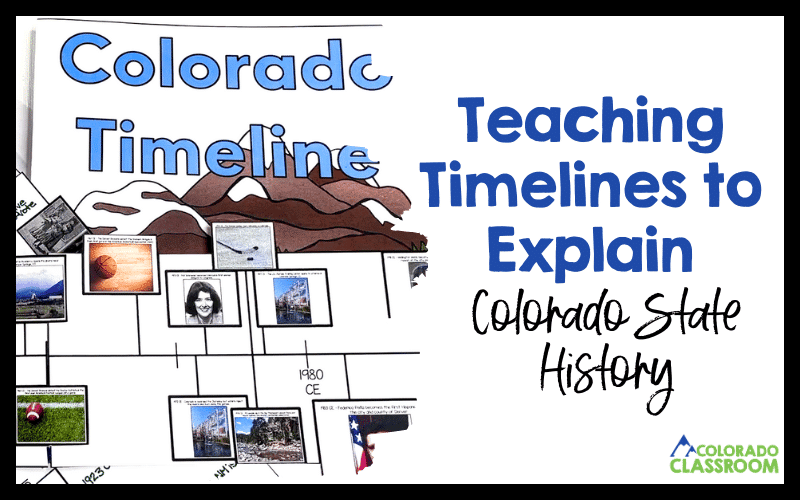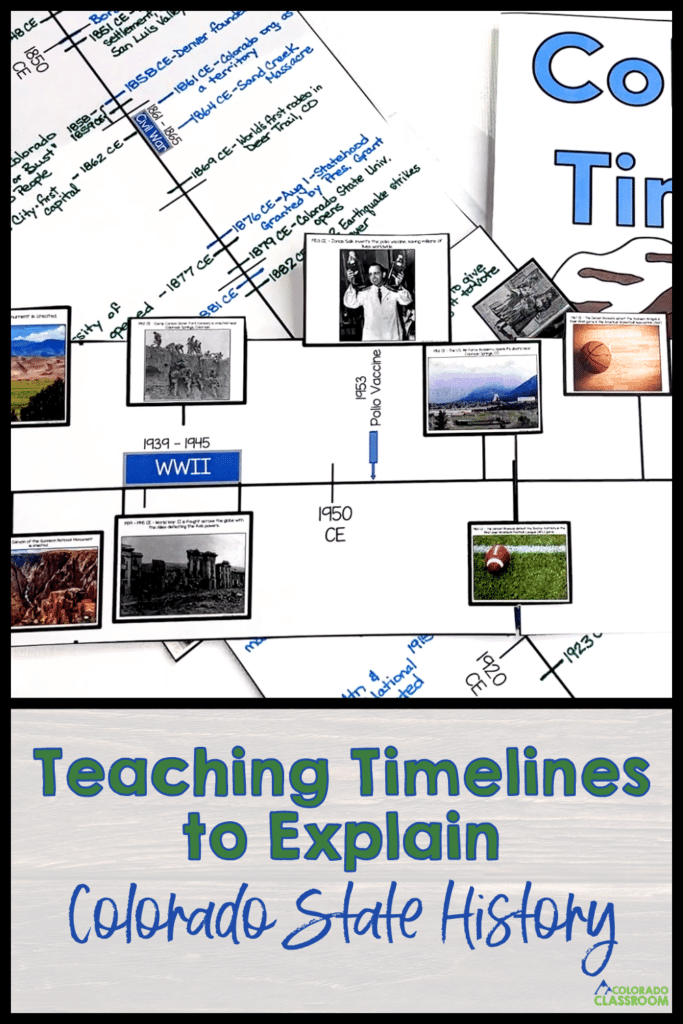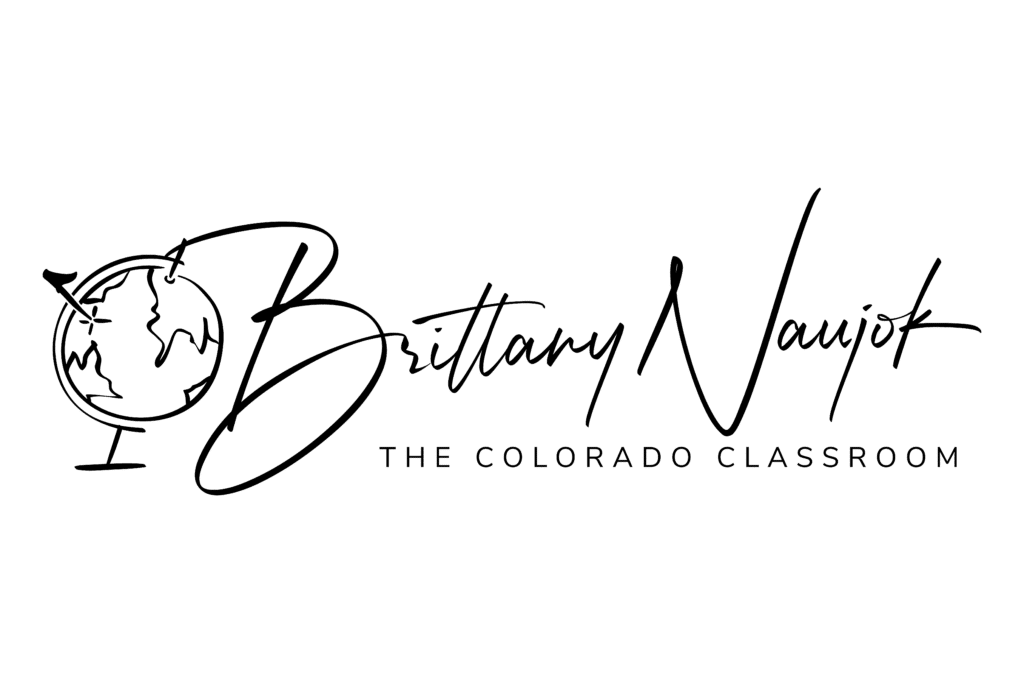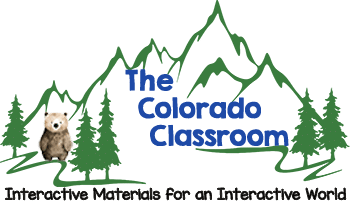Colorado State History: Authentic Learning By Teaching Timelines
Using timelines to explain Colorado state history is a powerful way to help our students connect the dots between events and see the bigger picture. I’ve found that when my students can visually track the sequence of events, it brings history to life in a way that’s both engaging and memorable. Timelines allow our students to map out significant moments in Colorado’s past and make it easier to understand how the state developed over time. Today, I’m sharing some of the timeline resources I use when teaching the state history of Colorado!

Benefits of Teaching Timelines
Using timelines to teach the state history of Colorado, or any history topic, is one of my favorite ways to get my students excited about learning. When students can visually track the sequence of events, it feels like they’re piecing together a story. Instead of just memorizing dates, they get to see how all the events connect, and, suddenly, the bigger picture starts to make sense.

What I love most about timelines is that they really help students visualize how Colorado developed over time. For example, when they see the Gold Rush on a timeline, followed by Colorado becoming a state, it just clicks for them. They start to see how one event leads to another, and that’s when the lightbulb moments happen.
Timelines also cater to different learning styles, especially for visual learners who love seeing everything laid out in front of them. Plus, they’re such a great way to spark critical thinking. Students aren’t just jotting down dates. They’re asking questions like, “How did this event change things for Colorado?” or “What if this event didn’t happen?” Those kinds of questions deepen their understanding and make history feel relevant.
Another perk of using timelines is how flexible they are. You can start with a simple overview and then let students dive in, adding their own research and discoveries. This makes the learning experience personal and gives them a sense of ownership over what they’re learning. Let’s be honest, watching students add to their timelines is always rewarding! Students can get super creative. They can draw out their own designs, add fun illustrations, or even go digital.
Teaching students about timelines makes the lessons more interactive and exciting for students. When they start to see the connections and understand how the past has shaped the present, that’s when history becomes more than just a subject. It becomes a story they’re eager to explore.
What Does Teaching Timelines Look Like in a History Class?
When it comes to teaching timelines in a history class, it’s all about making the past feel accessible and connected. Teaching timelines isn’t just about putting dates in order. It’s about helping our students see the bigger picture and understand how events are interwoven to shape the world we live in today.

In my classroom, teaching timelines starts with an engaging hook. I like to introduce the concept by discussing a major event and asking them to think about what led up to it and what followed. This naturally leads us to building a timeline. As we piece it together, my students start to see how one event impacts another, creating a chain reaction throughout history.
Teaching timelines also involves a lot of student input. I’m a big believer in making history interactive, so my students actively participate in creating the timelines. We might start with a basic framework, and then students add in their own research, ideas, and even illustrations. This process helps them grasp the sequence of events but also deepens their understanding of historical cause and effect.
Another key aspect of teaching timelines is the variety of formats we use. Sometimes we work with large, collaborative classroom timelines that stretch across a wall. Everyone can add their pieces as we move through the curriculum. Other times, students create their own individual timelines in interactive notebooks or digital slides. By giving them different ways to interact with timelines, I can cater to various learning styles and keep things fresh and engaging.
What I love most about teaching timelines is that they provide a visual anchor for students. As we continue through the course, they can refer back to the timeline. By doing so, they’re making connections between new content and what they’ve already learned. It’s a powerful tool that helps solidify their understanding and makes history feel like a cohesive story rather than a collection of isolated facts.
Teaching Timelines Using the Colorado Timeline Unit

When it comes to teaching Colorado history, I always turn to my Colorado Timeline Unit. It’s the perfect way to help students put all the pieces together. Students see the events that shaped our state and how they are connected.
In this unit, I’ve made sure to provide plenty of options to fit different classroom needs and styles. This unit is available in both printable and digital formats. This gives you the flexibility to choose what works best for your classroom and your students.
For those who prefer a digital approach, the Google Slides version is a breeze to use. The timeline is already built and labeled, so students can dive right in. Simply choose between the black-and-white or color versions, and then start adding images and text to represent key events. All the provided images can be resized, so students can mix and match picture sizes as they go along, creating a timeline that truly reflects their understanding of Colorado’s history.
If you prefer hands-on activities, the printable PDF version is for you. In this format, you’re given four choices for their timeline. There are two black-and-white and two full-color options. From there, your students can decide between a more visual timeline, packed with pictures, icons, and symbols, or a more text-heavy version with just a few images to highlight key moments. Once they’ve made their choice, students get to cut and paste or rewrite items onto the timeline as they learn about the events that shaped Colorado’s past. It’s a tactile experience that really helps reinforce the material!
I’ve also included full-page color posters that you can use to create a timeline around the room. This is a fantastic way to keep history visible and interactive in the classroom. As you move through the lessons, you can add to the timeline, creating a living history display that your students can refer back to throughout the unit.
Using Timelines to Teach History
Once you have chosen the timeline format you’d like to use, it’s time to get busy. There are many different ways you can use timelines in your lessons, but I have two favorites. One would be at the end of a unit. This method allows the timeline creation to serve as a review of what was taught. It’s an authentic way to revisit the events and dig in a little deeper. The other option would be to add to your timelines as you teach. For this approach, create the timeline base at the beginning of the year or the unit. Then add to the timeline each time you dive into a new event.
Using that second approach, I combine a variety of engaging and interactive activities together, with the timeline being just one of those things. Together, my students developed a well-rounded and solid understanding of each of the events that have played a part in Colorado’s history.

I am working to put the resources I have used into lessons that go hand-in-hand with the Colorado History Timeline. The first one is the Paleo-Indians and Mega-Fauna. This is a fascinating topic that always captures students’ imaginations!
This lesson kicks off with a reading about a prehistoric man hunting big game in Colorado. It’s a great way to set the stage and get students thinking about what life was like back then. To help them dive deeper, I’ve included a foldable activity where they explore the who, what, when, where, why, and how of the Paleo-Indians. This foldable is fun to create but also helps students organize and retain the key details.
Next up is a three-pocket card sort with 12 cards. There’s room for more if you want to expand! This activity gets students actively involved in categorizing information, which is a great way to reinforce their learning while also firing those critical thinking neurons. They’ll also tackle comprehension questions that challenge them to analyze the material in a new way.
One of my favorite parts of this lesson is the Beringia Land Bridge map. Students get to color the map, which visually ties into the historical content we’ve discussed. It’s a hands-on way to connect geography with history, and my students always enjoy it. We also explore the Uses of Animals in Society activity, which helps students understand the significance of animals in Paleo-Indian life.
Everything in this lesson is available in both black-and-white and color formats. You can choose between printable PDFs or digital versions. This flexibility means that whether you’re working with paper or screens, the lesson adapts seamlessly to your classroom needs.
Additional Resources for Colorado State History
Teaching timelines has truly transformed the way my students connect with history. It’s amazing to see how these visual tools bring the past to life and help students grasp the significance of each event. As much as I love teaching timelines, they’re just one piece of the puzzle when it comes to exploring Colorado State History. To really dive deep, I rely on a variety of additional resources for our study and make history even more engaging. Make sure to explore some of my favorite resources that you can incorporate into your classroom!
- Famous People Who Made Colorado What It Is Today
- 10 Engaging Activities to Teach Colorado Government to Students
- History of Colorado: Forging a Rich Tapestry with Diverse Groups
Organize History By Teaching Timelines
Organize history by teaching timelines, and you’ll see just how powerful this approach can be in making history meaningful and memorable for your students. Timelines offer a clear, visual way to connect events, spark curiosity, and deepen understanding. Whether you’re using them to explore Colorado’s rich history or diving into other historical periods, teaching timelines brings the past to life in a way that’s both engaging and effective. So, get creative, involve your students, and watch as they start to see history as a story they’re excited to learn about. Let’s keep making history come alive, one timeline at a time!
Save for Later
Remember to save this post to your favorite history Pinterest board for quick access to these resources to help with teaching timelines!


